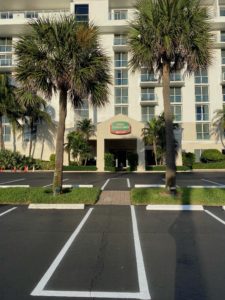Can Sealcoating Take Place in the Winter?
 If you want your asphalt pavement to have the longest life possible, you should sealcoat it periodically. A high-quality sealcoat serves as a sunblock to prevent ultraviolet radiation from making the pavement dry, brittle, faded, and prone to cracking. Sealcoating also make it more difficult for automotive fluids and corrosive chemicals to reach the pavement and make it soft and crumbly. Although highly effective, sealcoating is relatively inexpensive, especially when compared to the cost of rebuilding the pavement. However, sealcoating are sensitive products that must be applied under certain conditions if they are to cure and last as they should. This makes many people wonder whether it is possible to apply a sealcoat during the winter months.
If you want your asphalt pavement to have the longest life possible, you should sealcoat it periodically. A high-quality sealcoat serves as a sunblock to prevent ultraviolet radiation from making the pavement dry, brittle, faded, and prone to cracking. Sealcoating also make it more difficult for automotive fluids and corrosive chemicals to reach the pavement and make it soft and crumbly. Although highly effective, sealcoating is relatively inexpensive, especially when compared to the cost of rebuilding the pavement. However, sealcoating are sensitive products that must be applied under certain conditions if they are to cure and last as they should. This makes many people wonder whether it is possible to apply a sealcoat during the winter months.
How Important Is a Knowledgeable Sealcoating Contractor for a Successful Job?
The first requirement for a successful job is an experienced, reliable contractor who knows how to prepare the mix. Sealants are delivered from the manufacturer and this compound is combined with water, sand, and additives to be used for asphalt paving lot sealcoating. Treasure Coast seal coating contractors should also understand the other conditions that are necessary.
What Conditions Are Necessary to Ensure a Successful Sealcoating Job?
Sealants are extremely reliant on the weather for drying and curing. This is primarily due to the sealant’s need to evaporate the water that the mix contains.
• Temperature: The temperature of the pavement and the temperature of the air should both exceed 50 degrees Fahrenheit during the application and for the following 24 hours.
• Sunlight: For proper curing, asphalt sealcoating needs to be exposed to direct sunlight for several hours. On overcast days, the sealant will take longer to dry and cure.
• Humidity: Ideal humidity levels are around 50%, but Treasure Coast seal coating contractors know that humidity levels in the area are seldom that low. Fortunately, a successful job is possible until the humidity is around 90%.
• Wind: Obviously, spraying a liquid on any exterior surface during a gale is a very bad idea, but even calmer winds can be undesirable. Too much wind can make the top layer of sealant dry too quickly, and the liquid sealant below can continue to move, cracking the top layer. Conversely, too little wind can extend the drying time significantly.
• Rain: Frequently, precipitation is the biggest problem when sealcoating Treasure Coast pavements. If water falls on uncured sealant, the longevity and appearance of the sealant can be affected. The forecast should not include the likelihood of rain from the time of application until 24 hours after the application has been completed.
What Else Should Be Considered When Sealcoating Parking Lots in the Winter?
If large cracks, potholes, or other pavement damage is present, it will be necessary to make repairs prior to sealing the parking lot. Although your asphalt paving company or maintenance contractor can likely make the repairs in the winter, you should confirm that in the days leading up to your sealant application. You should also keep in mind that your lot striping and pavement markings will need to be repainted after the sealant cures. However, since pavement paints and sealcoats require roughly the same weather conditions, this is normally not an issue in South Florida.
Trust Asphalt Care Services to Build, Repair, or Maintain Your Pavements
We are a local Treasure Coast asphalt maintenance company offering an extensive range of services, including asphalt sealcoating, parking lot striping, asphalt repairs, speed bump installations, asphalt paving, thermoplastic line striping, concrete bumpers, and traffic signs. We have an exemplary reputation and impeccable references. If you are interested in requesting a free quote, you can complete our online form, or you can call 772-888-2840.




